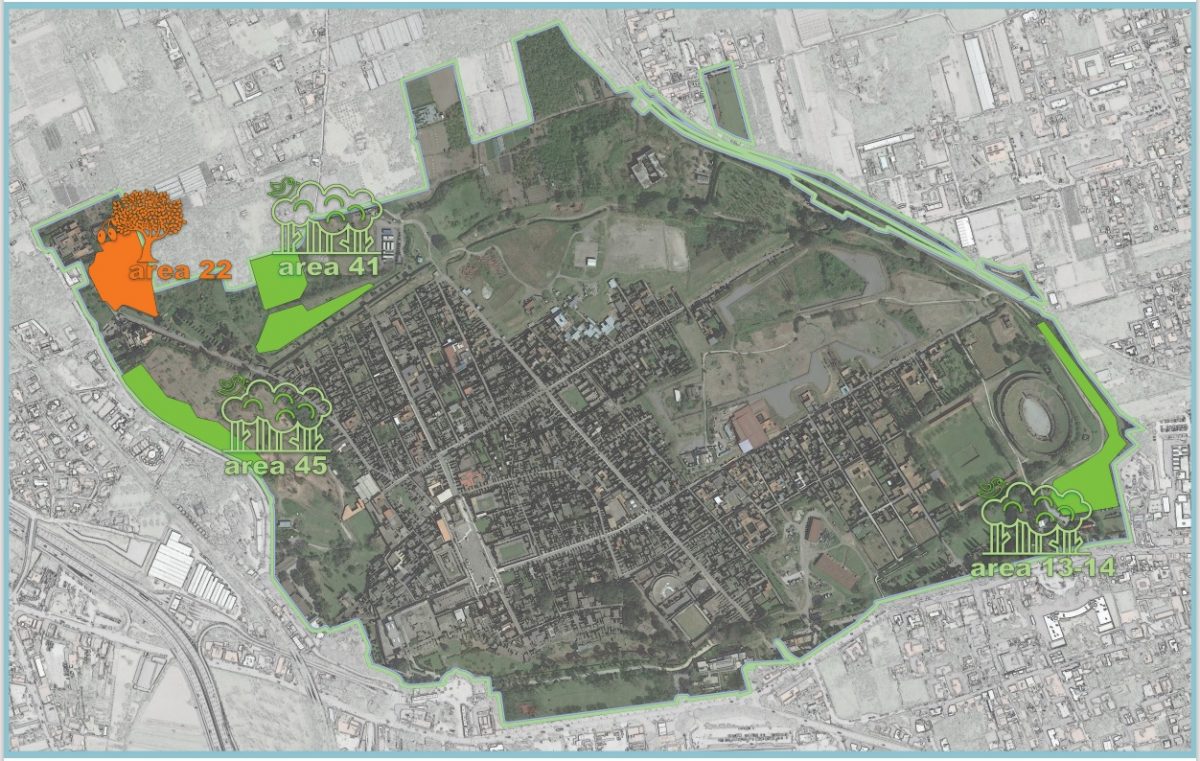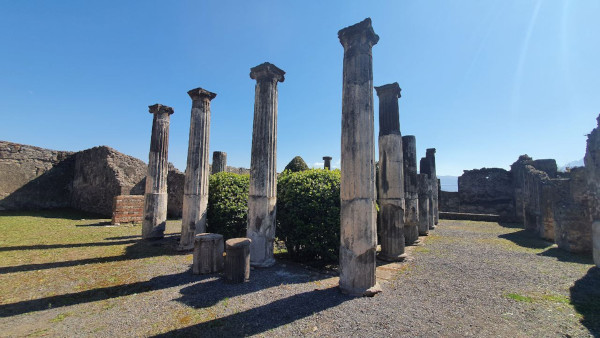NATIONAL LANDSCAPE DAY – 14th MARCH 2022
The PLANT NURSERY of POMPEII is born again at the House of Pansa
Special preview for Visitors to the Park
while creation of the WOOD at Piazza Anfiteatro gets underway
Programme of reforestation for the Green Areas of Pompeii
to enhance the biodiversity of the Archaeological Park
with the technical sponsorship of the Arbolia benefit corporation
The 14th March sees the celebration of National Landscape Day, which was established by the Ministry of Culture with the aim of promoting landscape resources through educational activities aimed at raising awareness and understanding of the landscape.
The Archaeological Park of Pompeii is presenting a PREVIEW for visitors, in the form of the new Plant Nursery of Pompeii, located in the garden of the House of Pansa (VI, 6 1-12), which will become a centre for the production of many species of Pompeian Flora which are rarely found in other plant nurseries, including botanical rarities and ancient species cultivated according to techniques practised in ancient Pompeii.
In 1827, the nineteenth century excavations, which uncovered the large residence facing onto Via delle Terme, identified a large garden with long rectangular beds for cultivation. In September 1943, Allied bombs struck the large garden, but in the late 1950s work began to create the first plant nursery to cultivate Pompeian Flora. Today, many years later, the plant nursery has been brought back to life, and regenerated with a project which, whilst adapting it to the changes which have occurred in recent times, systematically respects every archaeological and historical record.
The preview visit will allow the visitor to learn about the ollae pertusae, faithful reproductions of the disposable pots which the ancients used for the cultivation of plants, the willow bindings of the supporting posts for the collection of ancient roses, the balustrade of river reeds constructed using the technique evidenced by excavation data and garden paintings, and so much more that will be illustrated throughout the day by Official Paolo Mighetto and Pompeii’s Artistic Gardener Maurizio Bartolini.
The Plant Nursery will be open to the public throughout the day of the 14th March, with a view to a future permanent opening.
……..
 At the same time, the reforestation program of the green areas surrounding the walls of Pompeii has commenced, as part of the plan to increase the biodiversity of the more than 50 hectares of green heritage beyond the walls of the ancient city
At the same time, the reforestation program of the green areas surrounding the walls of Pompeii has commenced, as part of the plan to increase the biodiversity of the more than 50 hectares of green heritage beyond the walls of the ancient city
This project will involve the planting of over 4,000 new trees and shrubs , beginning with the Wood at Porta Anfiteatro.
It is a wood under construction - inspired by the intrinsic relationship between nature and the sacred within the ancient Mediterranean, which was expressed throughout the sacred woods of ancient memory, such as those of Nemi in Latium, but also in Pompeian paintings of ‘sacred landscapes’ dominated by large trees - with around 400 specimens of holm oaks, plane trees, tamarisks, elms and oaks, positioned solely by means of tossing white pebbles and planting where the pebbles fell, using stakes made of river reeds and raffia palm bindings to form thickets and clearings with rose bushes and strawberry trees to represent immortality, as well as myrtle and mastic trees.
The reforestation program of the Archaeological Park of Pompeii, which was begun a few months ago, will allow, between 2022 and 2024, the planting of over 6,000 trees and shrubs in new wooded areas, in the fertile green belt that will surround Pompeii.
Beginning with the landscaping of the promenade along the walls from Porta Anfiteatro to Porta Nola undertaken last Spring, as part of green maintenance works, the Archaeological Park of Pompeii planted 70 cypresses and 1,300 strawberry and mastic trees: then, during the summer, 225 established pines at Pompeii, including the majestic specimens along the walls of the ancient city, were rescued from parasitic attacks which would have killed them, thanks to the use of a specific endotherapeutic technique which was successfully employed by the Park’s Green Area Maintenance team.
The interventions were made possible thanks to the technical sponsorship and the agreement with the Arbolia benefit corporation, and to the contribution of Sa.Gest, a global technological services company which operates in the oil and gas, civil, industrial and energy sectors, which has also created and maintains ‘A Night At Pompeii’, the modern integrated audio-visual visitor experience.
The Archaeological Park of Pompeii is, alongside the Archaeological Park of the Colosseum, the sole institute of the Ministry of Culture which enjoys special autonomy to implement the duties of the Superintendency of Archaeology, Fine Arts and Landscape in their relevant jurisdictions, by virtue of the close link between the archaeological sites and the surrounding landscape.
THE TECHNICAL SPONSORSHIP OF ARBOLIA
Thanks to the technical sponsorship and agreement with the Arbolia benefit corporation - in line with its requests to promote concrete action to combat climate change, the improvement of air quality and the creation of green areas for the benefit of local communities - works have begun in the large green area by Porta Anfiteatro, where the rest and picnic area is situated, at the edge of the atmospheric Necropolis of Fondo Pacifico and at the boundary of the Necropolis of Porta Sarno. The intervention was made possible thanks to the contribution of Sa.Gest, a global technological services company which operates in the oil and gas, civil, industrial and energy sectors, which has also created and maintains ‘A Night At Pompeii’, the modern integrated audio-visual visitor experience.
This is a green area extending over 8,500m2 with significant landscape values, which is already partially used as a rest area for Park visitors. Here visitors may rest and relax immersed in an environment that is unique in the world, where the wood offers new paths, nesting sites and shelter for wildlife, as well as observation points. All of this, therefore, respects the philological rules of history and archaeology.
Even the tree and shrub species identified by Arbolia have been selected by the Archaeological Park of Pompeii from among the varieties which were recorded in the Roman Age, according to reconstructions based on studies of the natural elements of the ancient landscape.
The project is coordinated by Paolo Mighetto, Head of the Green Service of Pompeii and the areas beyond the walls, and represents an initial step in the reforestation program to enhance the biodiversity of the Archaeological Park of Pompeii.
This public-private sector collaboration has been made possible thanks to the Fundraising and External Relations Office of the Archaeological Park of Pompeii, which focuses on the collection of ideas and proposals, and studies and designs activities, together with cultural patrons.
For further information: pompei.fundraising@beniculturali.it
For Arbolia, this is the first of several forestation interventions which the benefit corporation will develop at the Archaeological Park of Pompeii. Founded on the initiative of Snam and the Fondazione Cassa Depositi e Prestiti per sviluppare nuove aree verdi in Italia, Arbolia designs, promotes and undertakes initiatives of forestation and reforestation of land which is made available by the public administration and private entities, with the economic support of companies which are sensitive to environmental sustainability.
In addition to planting, the benefit corporation also focuses on the care and maintenance of the trees for the first two years, thus relieving the public administration of the related burden.
The new urban wood of Pompeii raises to eighteen the number of green belts that have been created in Italy by Arbolia.



